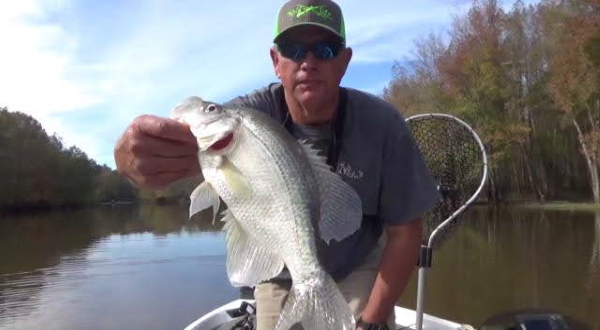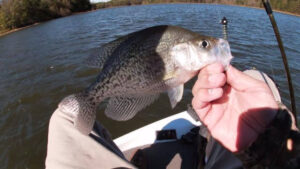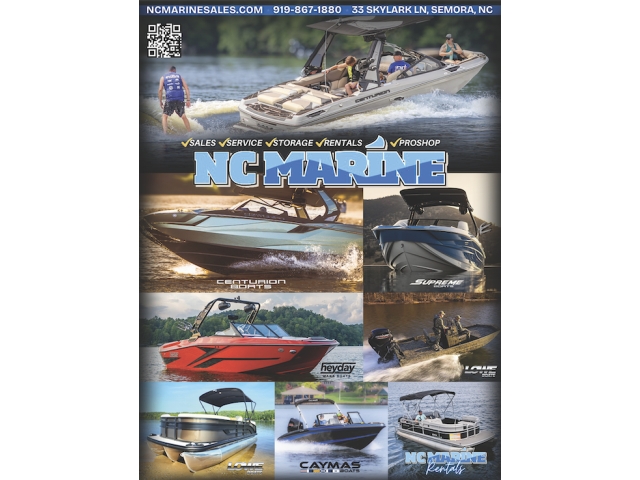
A Time of Transition
Fall is one of my favorite times of the year to fish. The fish are starting to feed up for winter, the temperatures are cooler, and the boat traffic has slowed down as people are winding down from summer watercraft activities.
Fishing the Summer Pattern
All during summer, the water has been hot and the fish have been staged in deep water, holding around structures; bass, crappie, and other predator fish are all holding a similar pattern. If you have good electronics, you can find and target these fish on this type of pattern and can catch a good number. This type of fishing pattern will continue into the fall, and depending on how fast the water cools down, may continue well into November.
 I like to find deep drop-offs with some type of structure such as stumps, logs, rocks, and creek channels which will all hold fish in great numbers. Vertical jigging a minnow or plastic jig, or dropping a metal spoon will result in catching fish. I have seen several hundred crappie all in one school holding around this type of structure. It is amazing to watch on my Livescope how the fish react to my lure as it drops down. You can see a half dozen or so fish coming up to try to be the first to eat the lure. Now, I know some of you reading this article are going to say, “How in the world can he see that?” On my boat, I have what is commonly referred to as a Panoptic Livescope. The fish give off a heat signature, and that picture is captured and translated on my screen in real-time video. Much like playing a video game, I can see if fish react to a lure positively or negatively, or have no reaction at all.
I like to find deep drop-offs with some type of structure such as stumps, logs, rocks, and creek channels which will all hold fish in great numbers. Vertical jigging a minnow or plastic jig, or dropping a metal spoon will result in catching fish. I have seen several hundred crappie all in one school holding around this type of structure. It is amazing to watch on my Livescope how the fish react to my lure as it drops down. You can see a half dozen or so fish coming up to try to be the first to eat the lure. Now, I know some of you reading this article are going to say, “How in the world can he see that?” On my boat, I have what is commonly referred to as a Panoptic Livescope. The fish give off a heat signature, and that picture is captured and translated on my screen in real-time video. Much like playing a video game, I can see if fish react to a lure positively or negatively, or have no reaction at all.
During the fall, crappie will be aggressive and will bite most anything that’s dropped to them, but just remember to match your lure color to the water clarity. If the water is clear, use a natural color lure. Shad colors are a good choice — Tennessee shad, or something with a blue color and metal flake in it. If the water is off-colored or stained, you can use an all-white lure or a yellow or chartreuse color. A gold or silver jigging spoon works well, too. A jigging spoon is not a popular way to fish for crappie in this area, but is a good choice to try. I keep one tied on all the time.
Fall Transition
As the day and nighttime temperatures cool and we move later into fall, we all start to look for the turnover. This can be a frustrating time for fishermen asking themselves, “Where did all the fish go?” This is what I asked myself last November on one of my fishing trips. As fall is in full swing, the two words “fall turnover” will be uttered by just about every angler on the water. When you mention your lake is turning over, you will seldom get a favorable or excited response from other anglers.
The upper layer that is warmest is called the epilimnion, the lower layer is the hypolimnion and in-between is the metalimnion — better known among anglers as the thermocline. As the summer goes on and grows warmer, so too does the epilimnion, (upper layer) pushing the metalimnion (thermocline) deeper.
Fall eventually arrives and the nights cool off. Surface waters begin to cool and sink, and the metalimnion starts breaking down and weakening. Wind is usually the driving force to complete the turnover.
Sometimes you can see visual signs that the lake is turning over, starting with the disappearance of the thermocline from your electronics. You may also see some foam on the water surface on a wind bank or notice bubbles rising from the bottom to the surface more often.
As fishermen, we want to be as successful as possible when we go out on a fishing trip, so I don’t want you to be caught off-guard like I was last fall. I had been on the same deep water fishing pattern from late summer all through fall, catching a good number of fish deep in 16 to 25 feet of water. We had a warm fall last year, and that caused the fall turnover to be in late November and early December. I headed to the lake one Friday and fished on five different brush piles in deep water and there were no large size fish holding on the brush, unlike the previous week when I caught a good number of larger size crappie. I was befuddled. Now, I had been looking for the transition all during fall, but it did catch me off guard.
Once the turnover occurs, it may take a few days to a week for the water to stabilize. To catch fish during this period, start fishing in shallower water. The predator fish are going to follow the bait fish to continue feeding. Start looking in long coves or the creek chains off the main lake. Since the top layer of water has cooled quite a bit, the fish feel more comfortable in the upper water column. Fish are deep in the summer because the water is cooler and it feels better. Just like you and me on a hot summer day — we like to stay where it’s cool. In the fall, the shallow water is the same temperature as the water at 18 feet deep, so fish are free to come up closer to the surface. They will still be holding around a structure such as boat docks, stumps, or fallen trees along the bank.
I have a theory about just how shallow these fish transition, but I will wait until I have tested my observations before I share that.
Tight lines, my friends!
Remember: it’s a Wild Life and I’ll see you on the water.
Check out Sam Seamster’s Facebook page and YouTube Channel: Wild Life Adventures![]()
![]()






























































































